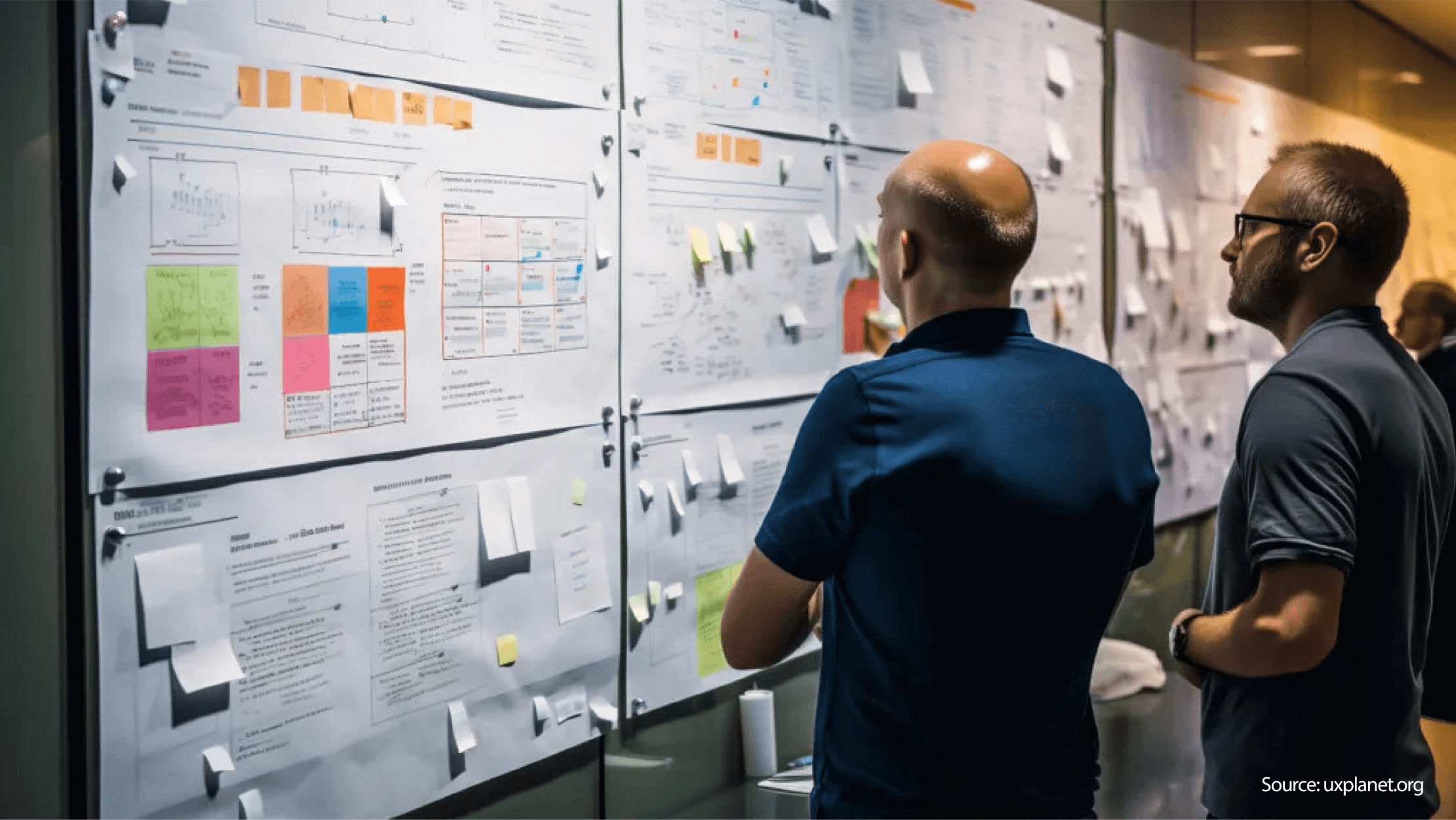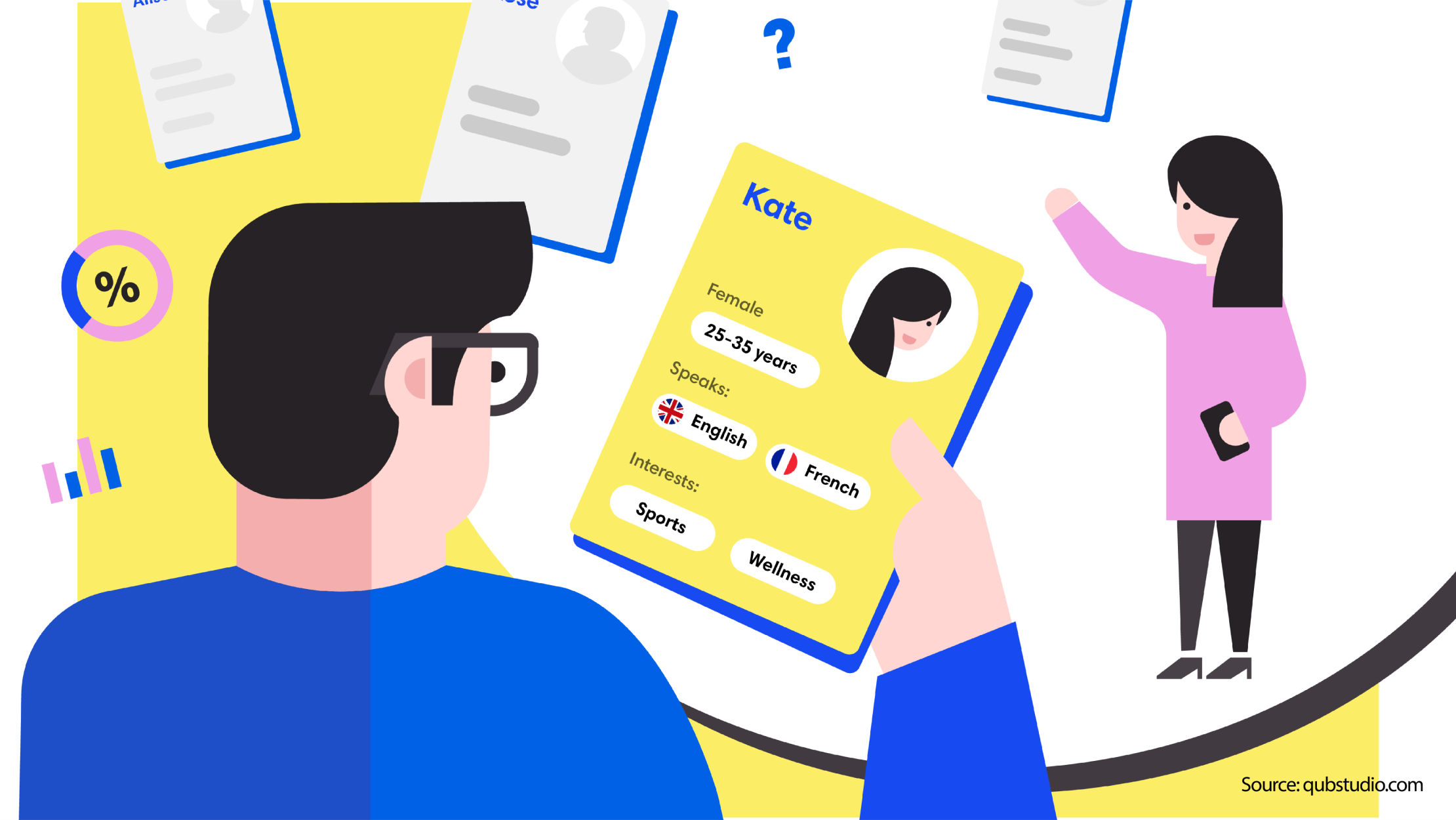Sure, we get it. Some companies already have marketing teams that have done the research. And while that’s great for understanding market segments, user research for UX goes deeper, it helps us design for actual user needs and behaviors. We’re not just creating pretty layouts; we’re building experiences that resonate with the people who will be using them.n.
So let’s break down why personas matter for both B2B and B2C sites and what the research process really looks like.
Why Are Personas So Important?
.png?updatedAt=1731997552890)
Personas help answer one of the most critical questions in UX design: who are we designing for? Without personas, we’re designing for everyone, which often translates to no one. Personas give us a clear, detailed picture of the user’s needs, motivations, pain points, and behaviors.
B2C Sites
For B2C websites, you’re often designing for a broad, diverse audience. Your personas might range from teenagers browsing for new sneakers to retirees planning their next vacation. Knowing the specific goals and expectations of these different user groups helps tailor the experience to them. For example:
- A younger audience might prioritize fast-loading images and bold, interactive design.Buttons with depth that give the illusion of being pressed.
- Older users may appreciate larger fonts, straightforward navigation, and accessibility features.
Without this understanding, your design risks alienating key user segments. A persona for a fashion e-commerce sitemight include details like:
- Name: Neha, 24
- Occupation: College student, part-time job at a coffee shop
- Tech Comfort Level: High
- Needs: Fast, fun experience with easy checkout, quick size guide access
- Frustrations: Complicated returns process, too many clicks to find products
With Neha in mind, we can create a tailored shopping experience that feels effortless for her.
B2B Sites
- A decision-maker persona might be someone like a COO who needs key info quickly and is likely accessing the site from a desktop during work hours.
- A technical persona, like a CTO, will want detailed specs, product comparisons, and maybe a downloadable whitepaper to justify purchasing decisions.
In B2B, you’re not designing for one person; you’re designing for teams, and your UX needs to cater to different layers of decision-making. Personas help you keep that balance and focus on designing for different user intents, whether they’re there to research or make a purchase.
Why UX Research Is Non-Negotiable
.png?updatedAt=1731997552955)
When clients ask us to cut UX research, we get it,it sounds like a hefty upfront cost. But skipping research is like launching a product without ever testing it. UX research allows us to gather the insights we need to:
- Understand user behavior: Knowing how users interact with your current site (or similar ones) allows us to optimize navigation, streamline checkout flows, and ensure engagement.
- Identify pain points: What frustrates your users? UX research helps uncover these pain points so we can eliminate them before launch.
- Design for inclusivity: Research helps ensure that the design is accessible and user-friendly for all potential users, not just one group.
The personas we develop out of this research are based on real data, they’re not just assumptions or guesses. And this is why UX research is essential, it’s the difference between designing for what we think users want and what they actually need.
The Steps We Follow for UX Research and Personas
So, what does this research process look like? Here’s the step-by-step breakdown of how we tackle UX research and build personas:
1. Stakeholder Interviews
We start by talking to you. We dive into what your business goals are, what the purpose of the site is, and how you see your users. This helps us understand your vision and ensure that the UX aligns with your goals.
2. User Interviews and Surveys
Next, we talk to your users directly. Through interviews and surveys, we gather insights about their behaviors, needs, frustrations, and what they expect from a site like yours. This might include:
- How they currently use your site (or competitor sites)
- Pain points in navigation or functionality
- What would make the experience better for them
3. Behavioral Analytics
Data doesn’t lie. We use analytics tools to track how users are engaging with your site, where they’re clicking, what pages they’re visiting, and where they’re dropping off. This helps us identify problem areas and opportunities for optimization.
4. Competitor Analysis
We’ll look at your competitors’ UX to see what’s working and what isn’t in your industry. This allows us to spot trends, benchmark your site against others, and find gaps we can fill with smart design choices.
5. Create User Personas
Using all the information we’ve gathered, we create detailed personas that represent your key user groups. These personas include:
- Demographic information: Age, occupation, location, etc.
- Tech comfort level: Are they beginners, intermediates, or experts?
- Goals: What are they trying to accomplish when they visit your site?
- Pain points: What frustrates them about current options or experiences?
- Preferred solutions: What features or design elements would solve their problems?
6. Map User Journeys
Finally, we map out the user journey. From first interaction to final conversion, we plot how each persona would engage with your site. This allows us to design an interface that meets their needs at every touchpoint.
The Future Formula: A Clear Path to Instant Personas

When speed is of the essence, our Future Formula comes into play, it's a simple equation designed to give us instant clarity on who we're designing for, without compromising on insight. Let’s break it down like an actual formula, so you can see how we create personas quickly and effectively.
The Formula: (Demographics + Behavior) + (Motivations + Pain Points) = Persona Clarity
This formula allows us to zero in on the essential elements that help shape the design. Let’s walk through how this works, step by step, using the example of IB boarding schools where fees can exceed ₹15 lakhs per year.
1. Demographics + Behavior
The first component of our formula helps us understand who the users are and how they typically act online.
Demographics: This includes age, location, family status, income level, and occupation. For an IB boarding school, for example:
- Parent persona: Sanjay, 42, Senior Executive, earning ₹40 lakhs/year.
- Student persona: Aanya, 16, tech-savvy, interested in extracurriculars like drama and science.
Behavior: This tells us how they use technology. Do they prefer mobile or desktop? Are they comfortable navigating online platforms? How do they interact with similar sites?
- Parent persona: Sanjay prefers detailed reports on a desktop.
- Student persona: Aanya uses her phone to browse and connect.
2. Motivations + Pain Points
The next step is figuring out what drives the user and what problems they face. Understanding this gives us the insight needed to address these issues in the design.
Motivations: What are they hoping to achieve? For example:
- Parent persona: Sanjay’s goal is to ensure his child has access to the best education and is well-prepared for global universities.
- Student persona: Aanya wants a community that balances academics with social experiences and extracurriculars.
Pain Points: What obstacles stand in their way?
- Parent persona: Sanjay is concerned about the high fees and needs reassurance that the education justifies the cost.
- Student persona: Aanya is nervous about leaving home and adapting to the boarding school environment.
By combining (Demographics + Behavior) with (Motivations + Pain Points), we create personas that allow us to understand who they are, how they act, what they want, and what frustrates them—all the essentials to make the right design decisions.
For example:
- Sanjay (Parent Persona): 42, Senior Executive, earns ₹40 lakhs/year, uses a desktop, concerned about fees but wants to ensure his child’s success. Needs easy access to reports and value justification.
- Aanya (Student Persona): 16, tech-savvy, uses mobile, motivated by extracurriculars, nervous about boarding life. Wants interactive features to explore the school environment and connect with the community.
Instant Clarity for Design

With the Future Formula, we gain instant clarity on how to design:
- For Sanjay: We prioritize a clear value proposition—highlighting university placements and success rates. His experience needs to include detailed reports, cost breakdowns, and easy-to-navigate sections on academic programs.
- For Aanya: The focus shifts to a dynamic user experience, with interactive features like virtual campus tours, social features, and mobile-friendly interfaces that let her explore the boarding experience.
This combination of personas, built from our Future Formula, guides the design process from start to finish, ensuring that we’re not just creating a generic site, but one that speaks directly to its audience.
Sample Sizes and Costs: What You Need to Know

When we talk about user research and creating personas, a big question that comes up is: how many people do we actually need to interview? And of course, what will it cost? Let’s break this down.
Sample Sizes for Persona Research
The good news is that you don’t need to interview hundreds of people to create effective personas. For most UX research, especially in the Indian market, a sample size of 10-15 interviews per user group is typically enough to identify patterns and key insights. This might sound small, but remember, we’re focusing on quality insights over quantity. You want to see consistent behaviors, motivations, and pain points across your user base.
Here’s a typical breakdown:
- B2C Sites: 12-15 user interviews
- B2B Sites: 8-12 user interviews (fewer but more in-depth)
Costs for UX Research in India
When it comes to cost, user research in the Indian context is more affordable compared to Western markets, but still varies based on scope. For reference:
- Recruitment costs: Finding the right participants can range from ₹500 to ₹2,000 per person depending on the niche and industry.
- UX Research & Persona Creation: Comprehensive research, including interviews, data analysis, and persona creation, generally costs between ₹1,50,000 and ₹5,00,000 (about $1,800 to $6,000). This covers the entire process from research to actionable insights.
So, while it might seem like an investment upfront, the value it brings to the overall user experience and, by extension, the success of your website or app is significant.
Personas Are Your Blueprint

To sum it all up, personas are not just a nice-to-have, they are an essential part of the design process. Whether you're building for a broad audience or a specific niche, investing in UX research and personas ensures you’re designing something that’s truly meaningful to your users.
And with the Future Formula, our streamlined approach to building quick, actionable personas, we can keep the process efficient and cost-effective while still delivering valuable insights that drive the design. So the next time someone suggests skipping UX research, remember: knowing who you're designing for isn't optional. It is the foundation of great design.
At the end of the day, personas save you time and money by getting it right the first time. And that’s always worth the investment.

 All Work
All Work


